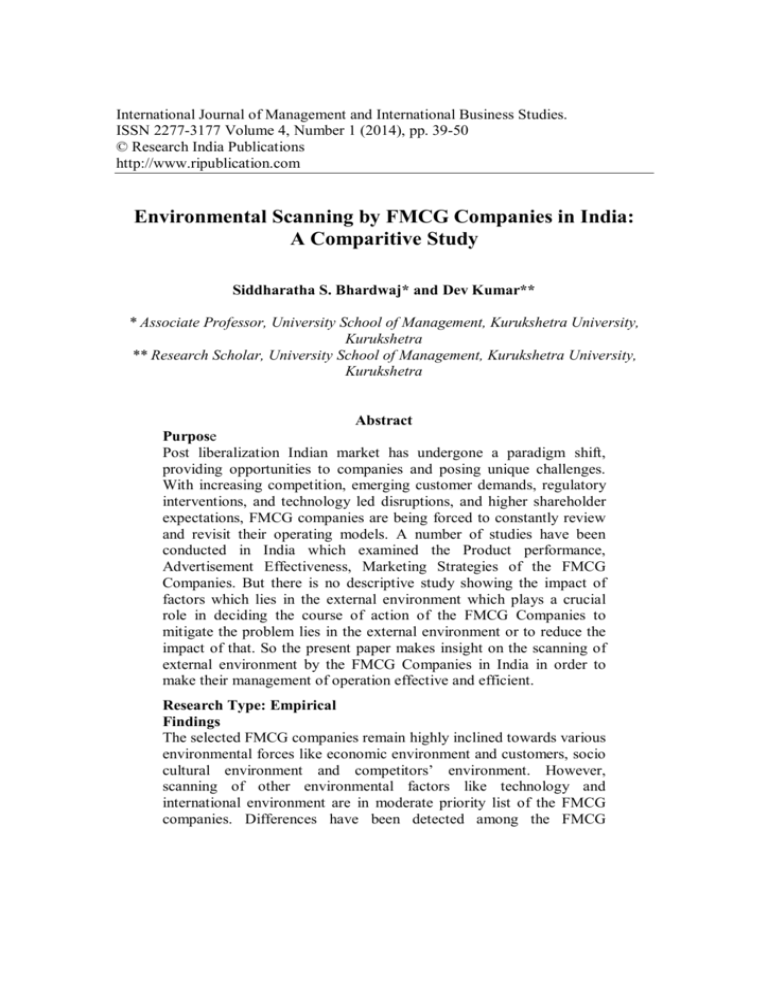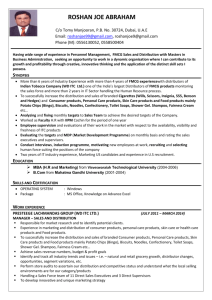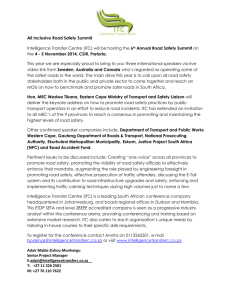Environmental Scanning by FMCG Companies in India: A
advertisement

International Journal of Management and International Business Studies. ISSN 2277-3177 Volume 4, Number 1 (2014), pp. 39-50 © Research India Publications http://www.ripublication.com Environmental Scanning by FMCG Companies in India: A Comparitive Study Siddharatha S. Bhardwaj* and Dev Kumar** * Associate Professor, University School of Management, Kurukshetra University, Kurukshetra ** Research Scholar, University School of Management, Kurukshetra University, Kurukshetra Abstract Purpose Post liberalization Indian market has undergone a paradigm shift, providing opportunities to companies and posing unique challenges. With increasing competition, emerging customer demands, regulatory interventions, and technology led disruptions, and higher shareholder expectations, FMCG companies are being forced to constantly review and revisit their operating models. A number of studies have been conducted in India which examined the Product performance, Advertisement Effectiveness, Marketing Strategies of the FMCG Companies. But there is no descriptive study showing the impact of factors which lies in the external environment which plays a crucial role in deciding the course of action of the FMCG Companies to mitigate the problem lies in the external environment or to reduce the impact of that. So the present paper makes insight on the scanning of external environment by the FMCG Companies in India in order to make their management of operation effective and efficient. Research Type: Empirical Findings The selected FMCG companies remain highly inclined towards various environmental forces like economic environment and customers, socio cultural environment and competitors’ environment. However, scanning of other environmental factors like technology and international environment are in moderate priority list of the FMCG companies. Differences have been detected among the FMCG 40 Siddharatha S. Bhardwaj & Dev Kumar companies concerning the extent to which these scan external environment on certain fronts. Practical Implications The management the FMCG Companies may start adopting Effective and Efficient Environmental scanning for External Environmental in order to improve their overall efficiency regarding, policy formulation, management practices, product management and controlling practices. Research Limitations The scanning of external environment, more often than not is considered a routine matter. Hence it may be bit tough for the managers to exactly reveal the extent to which their FMCG Company indulges in external environmental scanning. Further, confidentiality may prevent the managers to elaborate on the said issue. Keywords: FMCG, Environmental Scanning, Business Environment, External Environment. 1. Introduction Environmental scanning is the collection and use of information about events, trends, and relationships in an organization's external environment, the knowledge of which would assist management in planning the organization's future course of action. (Aguilar, 1967, Choo & Auster, 1993) Organizations scan the environment in order to understand the external forces of change so that they develop effective responses which secure and improve the position of the organisation in the future. They scan in order to avoid surprises, identify threats and opportunities, gain competitive advantage, and improve long-term and short-term planning. To the extent that an organization's ability to adapt to its outside environment is dependent on knowing and interpreting the external changes that are taking place, environmental scanning constitutes a primary mode of organizational learning. Environmental scanning includes both looking at information (viewing) and looking for information (searching). It could range from a casual conversation at the lunch table or a chance observation of an angry customer, to a formal market research program or a scenario planning exercise. Organisations today are facing unprecedented challenges in maintaining commercial survival and success. Due to the rapid changes happening in today’s marketplace and emerging business practices, it is more likely for an organisation, to fall behind by not keeping up with trends of the external environments (Albright, 2004). Environmental scanning, acts as “the first link in the chain of perceptions and actions that permit an organization to adapt to its environment” (Hambrick, 1981; Jennings & Lumpkin, 1992), has become an important aspect of strategic management for coping with environmental uncertainties, and the impact of environmental scanning to organizational performance. Environmental Scanning by FMCG Companies in India: A Comparitive Study 41 Choo (2001), Scanning or browsing behavior is influenced by external factors such as environmental turbulence and resource dependency, organizational factors such as the nature of the business and the strategy pursued, information factors such as the availability and quality of information, and personal factors such as the scanner's knowledge or cognitive style. Thus, many research studies on scanning investigate the effect of situational dimensions, organizational strategies, information needs, and personal traits on scanning behavior. 2. Literature Review From time to time, organizational environments undergo catastrophic upheavals which lead to changes that are so sudden and extensive that they alter the trajectories of entire industries, overwhelm the adaptive capacities of resilient organizations, and surpass the comprehension of seasoned managers (Meyer et al., 1990). While the environment of an organization is composed of an infinite set of elements outside the boundaries of the organization, other organizations, associations of individuals, and broad forces represent important segments of the organization's environment (Osborn and Hunt, 1974). Therefore, as the pace of changes in external environment accelerates, organizations’ survival increasingly depends on devising entrepreneurial responses to unforeseen discontinuities (Huber, 1984). Osborn & Hunt (1974) had observed that the literature on the environment of an organization and its direct and indirect impact upon organizational processes and outcomes is in a formative state. Even though Osborn and Hunt (1974) observed that there has been little agreement beyond the need for organizations to adjust to changes in the environment in order to be effective, a number of subsequent studies with firm/organizational/corporate performance as a dependent variable have treated the external environment as one of the independent constructs. Therefore, studies that have exclusively linked external environment and corporate performance are rare or may not exist, yet performance is contingent upon organizations’ appropriate alignment with environmental changes. A distinguishing characteristic of the strategic management discipline is the emphasis it places on the firm's competitive environment (e.g., Chandler, 1962; Child, 1972; Porter, 1980). An organization must find a match or fit between the demands of its competitive environment and its internal management systems in order to survive and succeed. (Vincent N. Machuki & Evans Aosa, (2011) has the opinion that the various environmental aspects were ranked differently on the number of issues organizations need to deal with. The literature on adoption of innovations has mostly focused on the factors affecting adoption and diffusion. One of the factors that affect technology adoption and diffusion includes the environment context (Scupola, 2003; Tonartzky and Fleischer, 1990). The environment context includes the external actors and factors that affect a company’s decision to adopt a technology, either directly or indirectly. These may include customers, competitors, market, government or economy. The external environment comprises the industry (suppliers and customers), the competitors, and dealing with regulatory bodies such as the government (Tonartzky and Fleischer, 42 Siddharatha S. Bhardwaj & Dev Kumar 1990). Scupola (2003) stressed that the competitors, the suppliers and the customers can exert direct or indirect pressures on SMEs to adopt new technology. The factor lies in the external environment have a great impact on the technology adoption. The cumulative impact of the factor is shown by table 1. Table 1: External Environmental Factors: Author Bu’rca, Fyner and Marshall (2005) Kim and Galliers (2004) Santarelly and D’altri (2003) Scupola (2003) Sadowski, Maitland, Van Dongen (2002) Chengalur-Smith, Duchessi (1999) External Factors Customer demand Supplier perspective Business environment Global markets Dynamic market Competitors Suppliers Customers Competitive pressure External support Incentives Market condition Competitors Hence the dynamics of external environment force the organization to adopt the strategies or course of action as per the need of the hour to survive in the industry if the organization fails to do so there become a question mark on the existence of the organization. In the same course of action the present paper make an insight on the scanning on the external environment by the FMCG companies’ i.e HUL, ITC and P&G in the FMCG Industry. 3. Objectives The major objectives of the study are as under: To know the extent to which the selected FMCG companies indulges in environmental scanning. To see which of the environmental forces influence the selected FMCG companies more. To asses if the selected FMCG companies differ in their environmental scanning pursuit. 4. Hypothesis Keeping in mind the objectives of the study following hypothesis has been tested: Environmental Scanning by FMCG Companies in India: A Comparitive Study 43 The selected FMCG companies do not differ significantly in their environmental scanning pursuit. 5. Research Methodology This is an empirical study. Both primary and secondary data is used by the researcher to arrive at necessary conclusions. The primary data have been collected to assess the extent to which selected FMCG companies scan different external environmental forces. For this the researchers have used a structured questionnaire addressed to the managerial cadre of the respective FMCG company. The questionnaire has been designed by the researchers keeping in mind prominent external environmental forces. In all, 53 managers from HUL, 57 managers from ITC and 50 managers from P&G have been included in the sample. The choice of the sample has been governed by judgment and convenience of the researchers. The secondary data incorporated in the research is the outcome of literature reviewed on the said theme. The data so collected have been analysed with the help of SPSS software using various statistical techniques like mean, standard deviation, ANOVA, post hoc analysis etc. and presented with the help of appropriate statistical tables. 5.1 Scope of the Study The present study aims at assessing the extent to which environmental scanning is done by Fast moving Consumer Goods Industry. Three top FMCG players of the country i.e Hindustan Unilever Ltd. (HUL), Indian Tobacco Company (ITC) and Proctor & Gamble (P&G) have been included in the sample of the study. HUL is the largest FMCG player of the country and offering more than 1000 verities of FMCG products across the globe. ITC, the Indian FMCG player operating in the country offering products in the rural as well as urban market while P&G is the prominent holding in the FMCG market across the globe. The data have been primarily gathered from the head offices of the companies and selected prominent branches of these in India. 5.2 Thrust of the Study The researchers, after reviewing literature on Environmental Scanning by FMCG companies have devised their own dimensions concerning same to garner the views of the respondents. The thrust of this study is on the following Environmental Factors as discussed with the help of figure 1: 6. Analysis and Interpretation 6.1 Economic Environment Table 1 indicates that all the selected FMCG companies with 4 plus mean rating remain inclined towards scanning economic environment. P&G and ITC being the largest international FMCG players chosen for the study, with a mean score of 4.64 and 4.57 respectively has been found most concerned on this front. This is justified on 44 Siddharatha S. Bhardwaj & Dev Kumar the ground that recent global economic meltdown had a more profound impact on the FMCG companies of India. The Hindustan Unilever Ltd. is slightly less, comparative to other two, is inclined towards the economic environmental scanning. ANOVA shows no significant difference among the selected FMCG companies. Post-Hoc analysis meanwhile has not indicated significant difference in between the three FMCG players at 5 per cent level of significance. Thus, extent of economic environmental scanning being undertaken by the selected FMCG companies is on expected lines. Economic Environment International Environment Political Environment Customer’s Environment Socio-Cultural Environment External Environmental Factors Legal Environment Supplier’s Environment Technological Environment Competitor’s Environment Natural Environment Fig. 1: External Environmental Forces. 6. 2 Political Environment Table 1 brings in some concerning scanning of political environment by the selected FMCG companies. Despite the fact that Indian political scenario remain rather unpredictable the selected FMCG companies pay attention towards scanning the political environment which is evident from the mean score 4 plus for all of the three players. The mean scores of the FMCG companies obtained from their own managers have varied between 4.21 (ITC) to 4.60 (P&G). This clearly indicates that FMCG companies have much inclined towards political situation of the country. Further ANOVA and Post Hoc analysis also support the fact that there is significant difference Environmental Scanning by FMCG Companies in India: A Comparitive Study 45 between HUL and ITC & ITC and P&G on this front, whereas no significant difference seen between HUL and P&G. As evident from table 2 and 3, selected FMCG companies have been detected to differ significantly on account of proximity of their ANOVA and Post Hoc Analysis. 6.3 Socio-Cultural Environment Table 1 indicates that the HUL has been more focused in scanning socio-cultural environment viz-a-viz its counterparts. During the course of survey, the respondents (managers) of HUL revealed that scanning of socio-cultural environment is necessitated in FMCG case to segment and target their clients for a particular type of product. For instance the company endeavours to target higher social class for its premium class category products in comparison to general category. P&G and ITC, meanwhile scan socio-cultural environment to the same extant. The selected FMCG companies have been found differ significantly by application of ANOVA (Table 2). If we consider two FMCG companies at a time, HUL has been found differ significantly with both ITC and P&G while difference between ITC and P&G is not significant at 5 per cent level of significance (Table 3). Legal Environment Table 1 indicates that the selected FMCG companies are paying high attention on scanning of legal environment as mean scores obtained by these have varied between 4.11 (HUL) to 4.22 (ITC) and 4.32 (P&G). ANOVA (Table 2) and Post-Hoc tests (Table 3) have not indicated significant difference among and in between them (Table 2 and 3). Managers of all the selected FMCG companies claimed that rules and regulations regarding packaging, advertising keep on changing and they need to keep an eye on such changes. Technological Environment Table 1 clearly indicates that scanning technological environment remain in scheme of things of the selected FMCG companies. The mean scores obtained by HUL and ITC Bank are 3.6 and 3.9 while the same is above 4 in case of P&G. When the respondents of all the FMCG companies enquired emphasised on the point that technology has revolutionised the modern day production process. Adapting to technology not only makes production operations more convenient to organisation but company also stand to fulfill the day to day increasing demand of the products. Further ANOVA (Table 2) and Post Hoc tests (Table 3) also give significant difference between all of the three players on this front. Natural Environment The managers of the FMCG companies have inclined towards high score concerning the extent to which they scan natural environment. The mean scores obtained by the FMCG companies have varied between 4.46 (P&G) to 4.49 (HUL) clearly indicating a strong attitude of theirs. The respondents of all the FMCG companies revealed that 46 Siddharatha S. Bhardwaj & Dev Kumar natural environment is of great prominence in FMCG industry. As they have to make decision on the production of products by taking in to consideration of geographical and climatic conditions. Competitor Environment Scanning competitors’ environment has been detected to be among the top most priority of the selected FMCG companies. There is not much to choose among the selected FMCG companies as each of these has got a mean rating of 4.5or in proximity. Needless to say, the FMCG companies have not been detected differ significantly. In fact, the competition in FMCG industry of India is fierce and each and every FMCG company is feeling like getting the privilege of customers over the competitors. Scanning competitors’ environment is bound to be the top priority under these circumstances. Suppliers Environment As revealed from table 1 the selected FMCG companies have been found giving priority to the scanning of suppliers’ environment. Although mean scores obtained by FMCG companies have been varied between 3.8 (P&G) to 4.6 (HUL), these are enough to suggest that the selected FMCG companies are ignoring suppliers at all. In fact the FMCG companies remain in need of various raw materials providers, forward and backward linkages etc. Thus, suppliers can not be completely discarded. The selected FMCG companies have found differ significantly which is evident from the ANOVA (Table 2) and Post Hoc Test (Table 3) on this front. Customers Environment Like competitors environment, customers’ also remain in top agenda of the selected FMCG companies. The managers of all the FMCG companies have accorded very high score on this front conveying their inclination in studying and getting reactions of their customers. In fact, ignoring customers is nothing short of suicidal tendency in a fiercely competitive era. The high scores are thus quite justifiable (Table 1). The high scores obtained by all the selected FMCG companies have ensured that these do not differ significantly as evident from ANOVA and Post Hoc Test (Table 2) and (Table 3). 6.4 International Environment The FMCG companies have been found attaching importance to the scanning of international environment with average mean score of 3.6. The interaction with the companies’ manager reveals that International Environment scanning is always necessary whenever the company extends its operation in the overseas market. And on the same ground it is evident from the, Table 2& Table 3, i.e ANOVA and Post Hoc Analysis test that there is no significant difference among the three FMCG players. 7. Conclusion Environmental Scanning by FMCG Companies in India: A Comparitive Study 47 To sum up, it may be said that FMCG players in FMCG industry indulges in external environmental scanning. Various environmental sectors such as competitor environment, customer environment , natural environment, economic environment, socio-cultural environment have been found to more rigorously scanned by the FMCG industry. The Hindustan Unilever Ltd. under study has been found more inclined towards scanning supplier environment than its counterparts. P&G is paying more attention to scanning of technological environment comparative to its counterparts. FMCG companies under study meanwhile pay attention to the scanning of legal environment to a great extant comparative to international environment. Table 1: Extent of Environmental Scanning by FMCG companies (Mean Comparison) Environmental Variable Economic Environment Political Environment Socio Cultural Environment Legal Environment Technological Environment Natural Environment Competitor Environment Supplier Environment Customer Environment International Environment HUL 4.4906 4.5660 4.8679 4.1132 3.6415 4.4906 4.4340 4.6226 4.6038 3.6604 ITC 4.5789 4.2105 4.5439 4.2281 3.9298 4.4737 4.6842 3.9649 4.5088 3.7368 P&G 4.6400 4.6000 4.5600 4.3200 4.2400 4.4600 4.6200 3.8600 4.6000 3.6600 Source: Manager’s Survey. Table 2: Application of ANOVA Variable Economic Environment Political Environment Socio Cultural Environment Legal Environment Technological Environment Natural Environment Competitor Environment Supplier Environment Customer Environment International Environment F Value 0.942 4.981 8.087 8.834 12.686 0.026 3.330 25.048 0.643 0.169 Significance 0.392 0.008* 0.000* 0.436 0.000* 0.975 0.038* 0.000* 0.527 0.845 *The mean difference is significant at 0.05 leve l significance. Table 3: Post-Hoc Comparison. Dependent Variable Economic Environment. (I) FMCGCompany J) FMCGCompany HUL ITC Sig. 0.407 48 Siddharatha S. Bhardwaj & Dev Kumar ITC P&G Political Environment. HUL ITC P&G Socio Environment Cultural HUL ITC P&G Legal Environment. HUL ITC P&G Technological Environment. HUL ITC P&G Natural Environment. HUL ITC P&G Competitor Environment. HUL ITC P&G Supplier Environment. HUL P&G HUL P&G HUL ITC ITC P&G HUL P&G HUL ITC ITC P&G HUL P&G HUL ITC ITC P&G HUL P&G HUL ITC ITC P&G HUL P&G HUL ITC ITC P&G HUL P&G HUL ITC ITC P&G HUL P&G HUL ITC ITC 0.175 0.407 0.572 0.175 0.572 0.010* 0.810 0.010* 0.006* 0.810 0.006* 0.000* 0.001* 0.000* 0.859 0.001* 0.859 0.461 0.200 0.461 0.561 0.200 0.561 0.013* 0.000* 0.013* 0.009* 0.000* 0.009* 0.898 0.821 0.898 0.918 0.821 0.918 0.013* 0.074 0.013* 0.528 0.074 0.528 0.000* Environmental Scanning by FMCG Companies in India: A Comparitive Study ITC P&G Customer Environment HUL ITC P&G International Environment WTO IMF. HUL Including ITC P&G P&G HUL P&G HUL ITC ITC P&G HUL P&G HUL ITC ITC P&G HUL P&G HUL ITC 49 0.000* 0.000* 0.368 0.000* 0.368 0.319 0.969 0.319 0.346 0.969 0.346 0.617 0.998 0.617 0.620 0.998 0.620 *The mean difference is significant at 0.05 level of significance. References [1] [2] [3] [4] [5] [6] [7] [8] [9] Albright, K. S. (2004), “Environmental Scanning: Radar for Success”, Information Management Journal, 38(3), 38-45. Burca, S., Fynes, B., Marshall, D. (2005), “Strategic Technology Adoption: Extending ERP across the Supply Chain”, Journal of Enterprise Information Management, 18(4), 427-40. Bennet, A., Bennet, D. (2004), “Organizational Survival in the New World: The Intelligent Complex Adaptive System”. Burlington: ButterworthHeinemann Publication, 12, 35-41. Chandler, A. D., Jr. (1962), “Strategy and Structure: Chapters in the History of the American Industrial Enterprise”, Cambridge, MA: MIT Press. Chengalur-Smith, I., Duchessi, P. (1999), “The Initiation and Adoption of Client-Server Technology in Organizations”, Innovation and Management. 35, 77-88. Child J. (1972), “Organizational Structure, Environment, and Performance: The Role of Strategic Choice”, Sociology, 6(1), 1-22. Chun Wei Choo (2001), “Environmental Scanning as information seeking and Organizational Learning”, Information Research, Vol. 7(1), 28-35. Duncan, R. G. (1972a), “Characteristics of Organizational Environments and Perceived Environmental Uncertainty”, Administrative Science Quarterly, Vol. 17(2): 313-327. Duncan, R. G (1972b), “Multiple Decision-Making Structures in Adapting to Environmental Uncertainty: The Impact on Organizational Effectiveness”, Human Relations, Vol. 26, 273-291. 50 Siddharatha S. Bhardwaj & Dev Kumar [10] Hambrick, D.C. (1981), “Specialization of Environmental Scanning Activities among Upper Level Executives”, Journal of Management Studies, Vol. 18, 299-320. [11] Hambrick, D. C. (1982), “Environmental Scanning and Organizational Strategy”, Strategic Management Journal, Vol. 3, 159-174. [12] Huber, G. P. (1984), “The Nature and Design of Post-Industrial Organizations”, Management Science, 30, 928-951. [13] Kim, L. & Lim, Y. (1988). “Environment, Generic Strategies, and Performance in a Rapidly Developing Country: A Taxonomic Approach”, The Academy of Management Journal, Vol. 31(4), 802-827. [14] Meyer A. D., Brooks G. R., and Goes B. J. (1990), “Environmental Jolts and Industry Revolutions: Organizational Responses to Discontinuous Change”, Strategic Management Journal, Vol. 11, 93-110. [15] Osborn, N. R. & Hunt, G. J. (1974). “Environment and Organizational Effectiveness”, Administrative Science Quarterly, Vol. 19 (2), 231-246. [16] Porter, M. E. (1980). “Competitive Strategy: Techniques for Analyzing Industries and Competitors”, First Edition, New York, Free Press. [17] Rogers, E. M. (1962) “Diffusion of Innovation”, 1st ed., New York, The Free Press. [18] Rogers, E. M. (2003) “Diffusion of Innovation”, 5th ed., New York, The Free Press. [19] Scupola, A. (2003), “The adoption of Internet Commerce by SMEs in the South of Italy: An environment, Technological and Organizational Perspective”, Journal of Global Information Technology Management, Vol. 6(1), 52-71. [20] Sadowski, B. M., Maitland C., Dongen J. (2002) “Strategic Use of the Internet by Small and Medium Sized Companies: An Exploratory Study”, Information Economics and Policy, 14, 75-93. [21] Vincent N. Machuki & Evans Aosa (2011), “The Influence of the External Environment on the Performance of Publicly Quoted Environment on the Performance of Publicly Quoted Companies in Kenya. Vol. 5, 17-25.








